







The Change Process: A comprehensive guide to successful change
What is a change process?
A change process describes the structured sequence of changes in an organization. It covers all steps from recognizing the need for change to its full implementation and anchoring in the corporate culture.
The importance of change management
Change management is the systematic approach to organizational changes. It aims to make the transition from an actual state to a desired target state as efficient and effective as possible.
Phases in change management
A successful change process typically goes through several phases:
1. Analysis: Recording the current status and defining the goals
2. Planning: Developing a change strategy and schedule
3. Implementation: Implementation of the planned change measures
4. Stabilization: Anchoring the changes in the organization
5. Evaluation: Assessment of success and, if necessary, readjustment
Change management models
There are various models that structure and explain the change process. Three of the most famous are:
1. Lewin's 3-stage model
- Unfreezing
- Changing
- Refreezing
2. Kotter's 8-stage model
1. Create urgency
2. Build a leadership coalition
3. Develop vision and strategy
4. Communicate vision
5. Remove obstacles
6. Plan for short-term successes
7. Consolidate changes
8. Anchor new approaches in the culture
3. The ADKAR model
- Awareness
- Desire
- Knowledge
- Ability
- Reinforcement
The change curve: emotional stages in the change process
During a process of change, employees go through different emotional stages, known as the change curve:
1. Shock and rejection
2. Resistance
3. Rational acceptance
4. Emotional acceptance
5. Openness and integration
6. Understanding these phases helps managers to respond appropriately to the needs of employees and to make the change process successful.
Success factors for the change management process
The following factors are crucial for a successful change process:
- Clear vision and goals
- Strong leadership and support from top management
- Effective communication
- Involvement of employees
- Provision of necessary resources
- Flexibility and adaptability
- Measuring and monitoring progress
The role of visualization in the change process
Effective visualization can significantly support and accelerate the change process. This is where DIALOGBILD comes into play. We specialize in visualizing complex change processes and making them tangible.
How DIALOGBILD supports the change process:
1. Creating an overview: A dialog picture visualizes the entire change process and makes it understandable for everyone involved.
2. Promoting communication: The picture serves as a basis for discussion and facilitates dialog between managers and employees.
3. Emotional activation: Emotions are addressed through the visual representation, which increases acceptance of change.
4. Provide orientation: The dialog picture shows the path from the current to the target state and thus provides orientation in the change process.
5. Increase motivation: By visualizing goals and milestones, employees are motivated to actively participate in the change process.
Practical tips for a successful change process
1. Analyze the initial situation: Understand exactly why changes are necessary and what goals should be achieved.
2. Develop a clear vision: Formulate a clear picture of the future that serves as a guide for everyone involved.
3. Communicate transparently: Provide regular information about progress and the next steps in the change process.
4. Involve employees: Create opportunities for employees to actively participate in the change process.
5. Train your managers: Equip your managers with the necessary skills to successfully lead the change process.
6. Celebrate achievements: Recognize milestones achieved to maintain motivation.
7. Stay flexible: Be prepared to adapt your strategy as circumstances change.
8. Use visual aids: Use visualizations such as DIALOGBILD to make the change process tangible.
Conclusion
A successful change process is crucial for the future viability of companies. By understanding the different phases, applying proven change management models and using visualization tools such as dialog pictures, you can effectively design and implement changes in your company. Remember: Change is not only a challenge, but also an opportunity for further development and innovation.
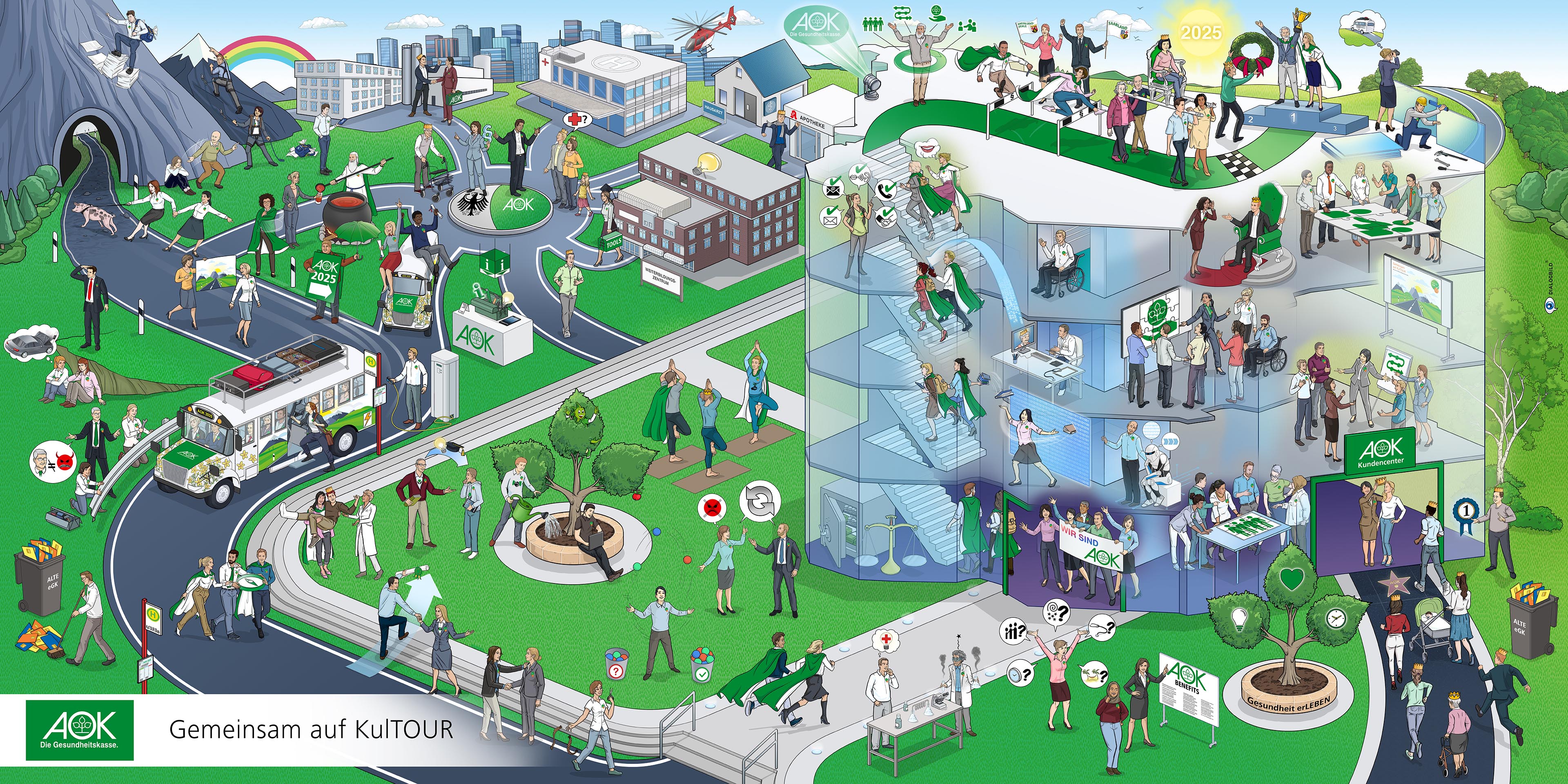
OUR CULTOUR CHANGE
WHO WE ARE. HOW WE ARE. WHERE WE WANT TO BE.
AOK Rheinland-Pfalz/Saarland - The health insurance company is the largest health insurance company in the two federal states of Rhineland-Palatinate and Saarland, with over 1. 2 million insured persons and 85,000 supervised employers as well as around 3,500 employees. The health insurance fund maintains business relationships with more than 100 hospitals, 10,000 doctors, psychotherapists and dentists, around 1,300 pharmacies and many hundreds of other contract partners. It offers high-quality care for the population and tailor-made concepts in the regions. For this, modern, future-oriented structures are also essential in the corporate culture. ...
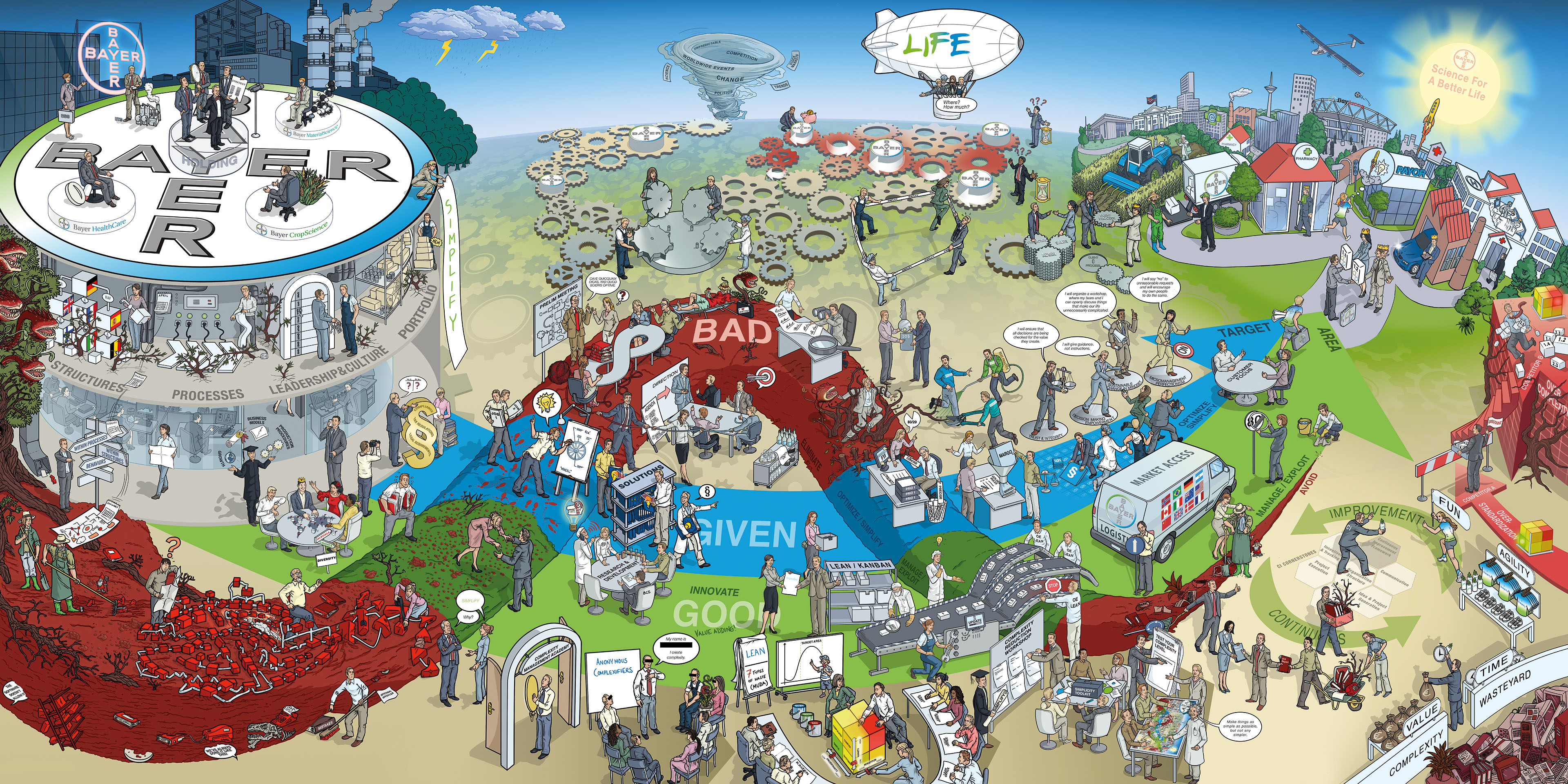
SIMPLIFY
"MAKE THINGS AS SIMPLE AS POSSIBLE, BUT NOT ANY SIMPLER."
Simplify - that's the goal of the complexity reduction program within Bayer AG. Working life should be made simpler, clearer and without unnecessary hurdles. Each employee can contribute to his or her area of responsibility. The dialog picture is used to talk about complexity and to identify it. It illustrates how complexity can arise, how it complicates daily work, why it harms the company. And there are tips and impulses, which can be against complexity. The dialog picture is a starting medium in complexity reduction workshops, serves as a general basis for discussion and is also offered on the intranet on PCs and iPad to deepen the topic. ...
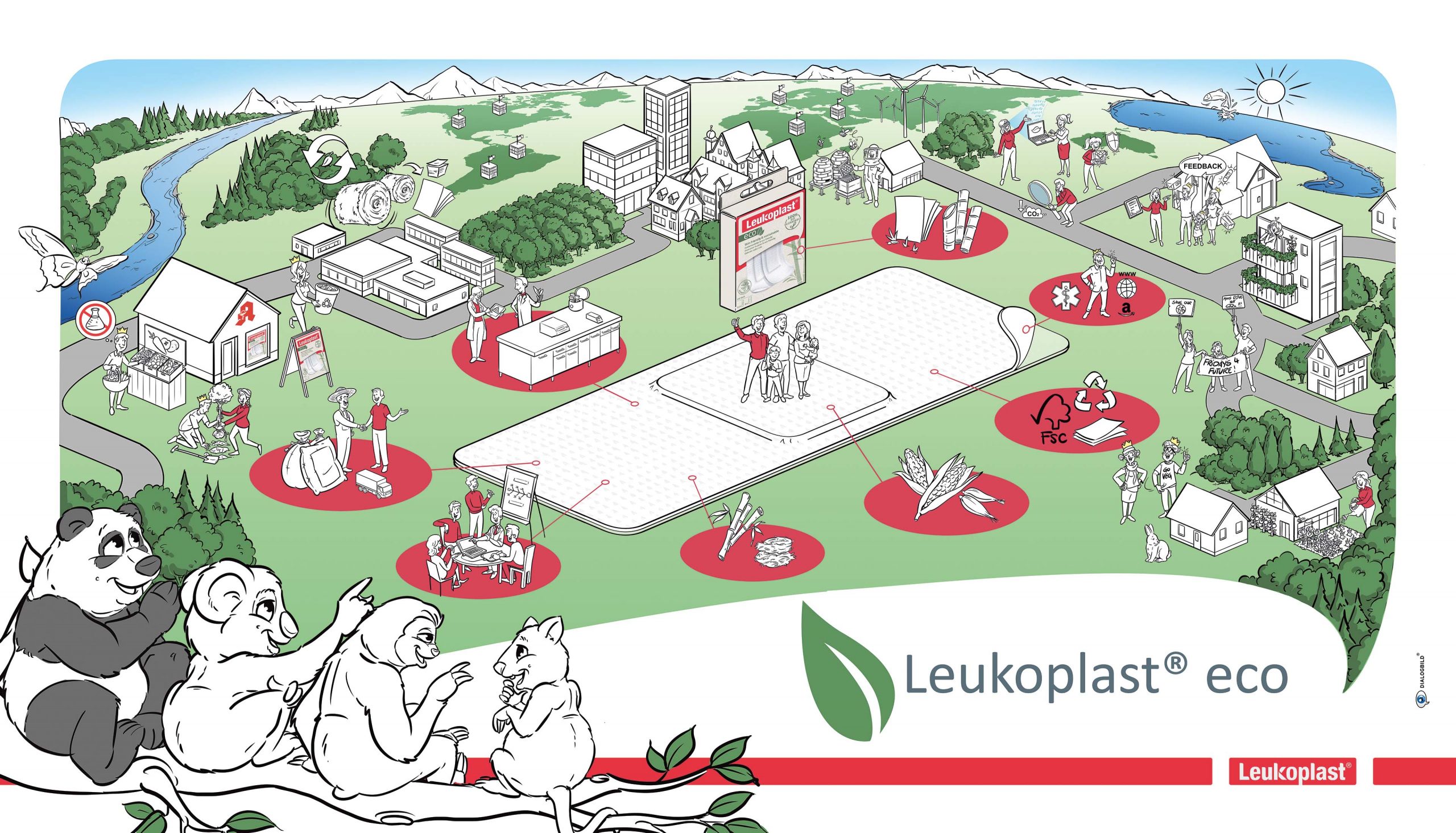
MISSION STATEMENT: FOR THE SAKE OF THE ENVIRONMENT
Essity works with more than 48,000 employees to adapt its own brands to the demands and developments of the zeitgeist while maintaining its own high quality standards. The variance of the product range in the Health and Medical Solutions segment extends across five brands, which are based on the common focus on pleasant applications and successful therapies for patients and users. ...
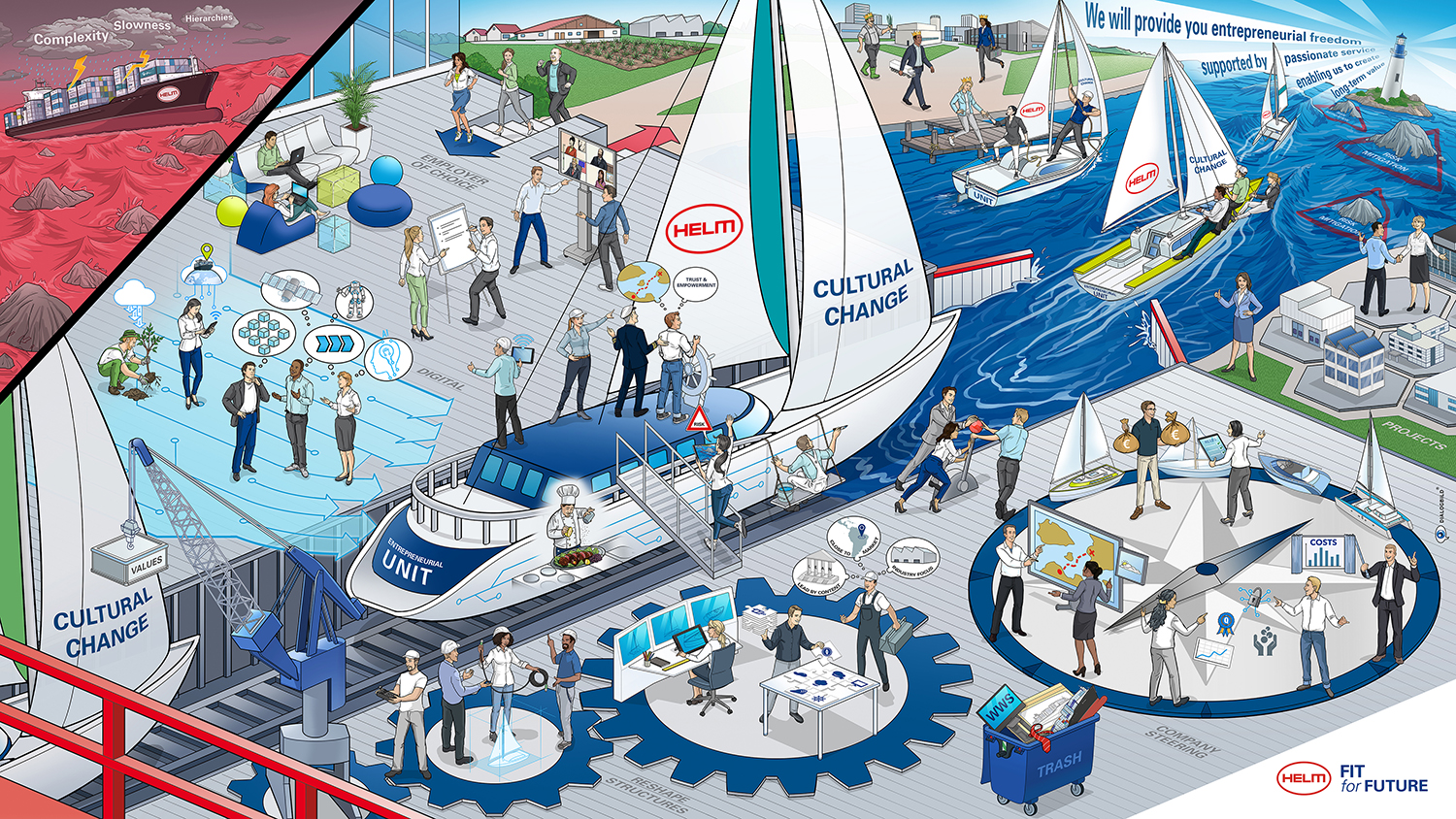
FIT FOR FUTURE
Helm is a globally active family-owned company headquartered in Hamburg, Germany. The fields of activity are the business units Chemicals, Fertilizer, Coop Protection and Pharma, which our company with its 1,500 employees takes care of.
In the course of the transformation process, we decided to use a dialog picture in order to communicate the different aspects and areas to our employees in an understandable and easy-to-remember way. For this purpose, each employee also received his or her own picture after the company meeting. ...
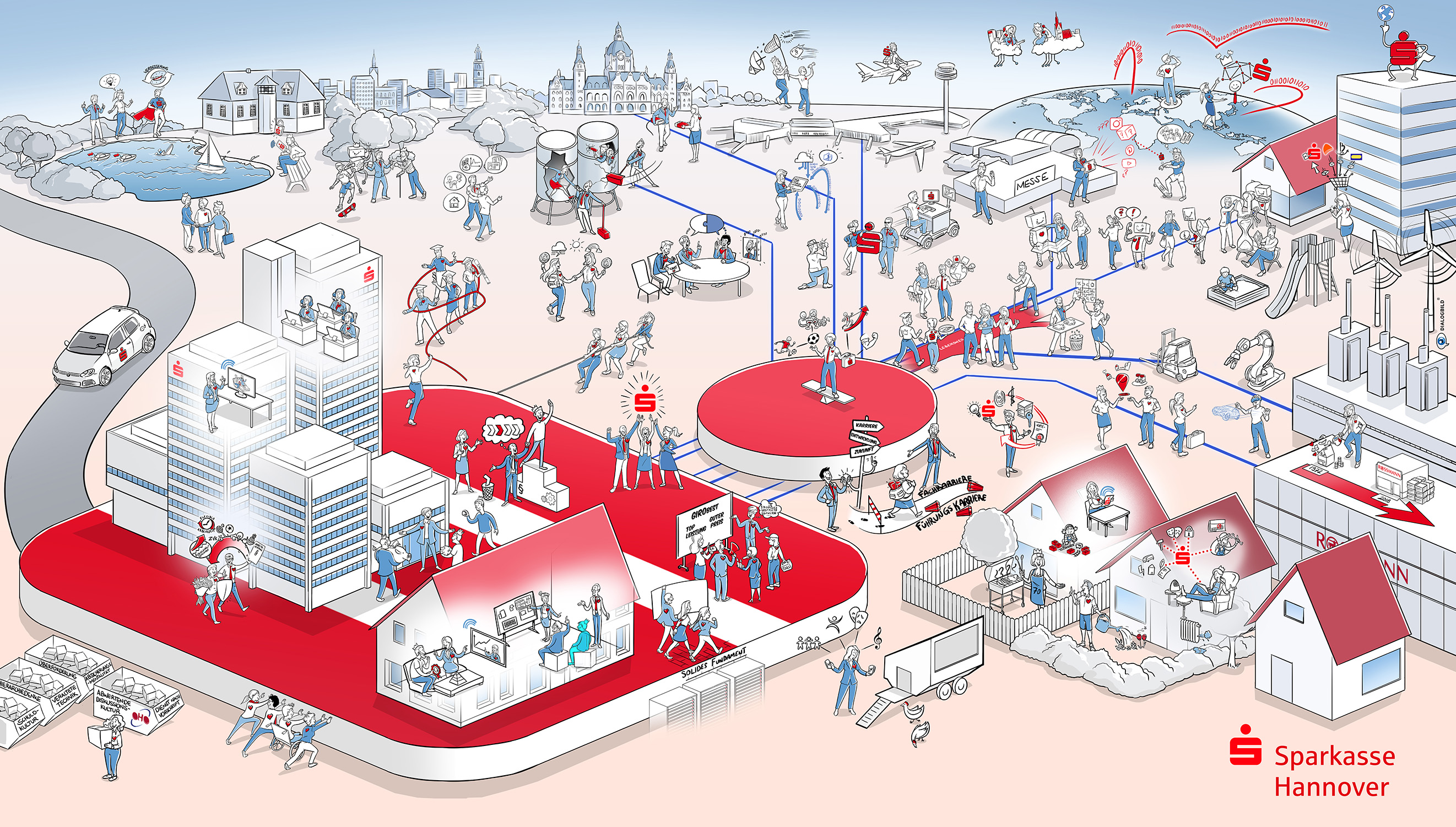
CULTURE CHANGE
AN IMAGE THAT STIMULATES DIALOG ABOUT THE FUTURE
Sparkasse Hannover, one of the largest savings banks in Germany, began to address the process of cultural change as early as the beginning of 2017. In several workshops, the questions "how is digital change changing Sparkasse Hannover?", "what does Sparkasse Hannover stand for in the future?" and "what common goals do we have?" were discussed from both employee and customer perspectives and then visually translated.
Low interest rate environment, stricter regulation, high competitive pressure from banks and non-banks - this situation is the new reality in the banking business. It is not the circumstances that will change, but the institutions that will have to adapt to the new circumstances. Without strategic and operational adjustments, interest-based business models will not work in the low interest rate environment. ...
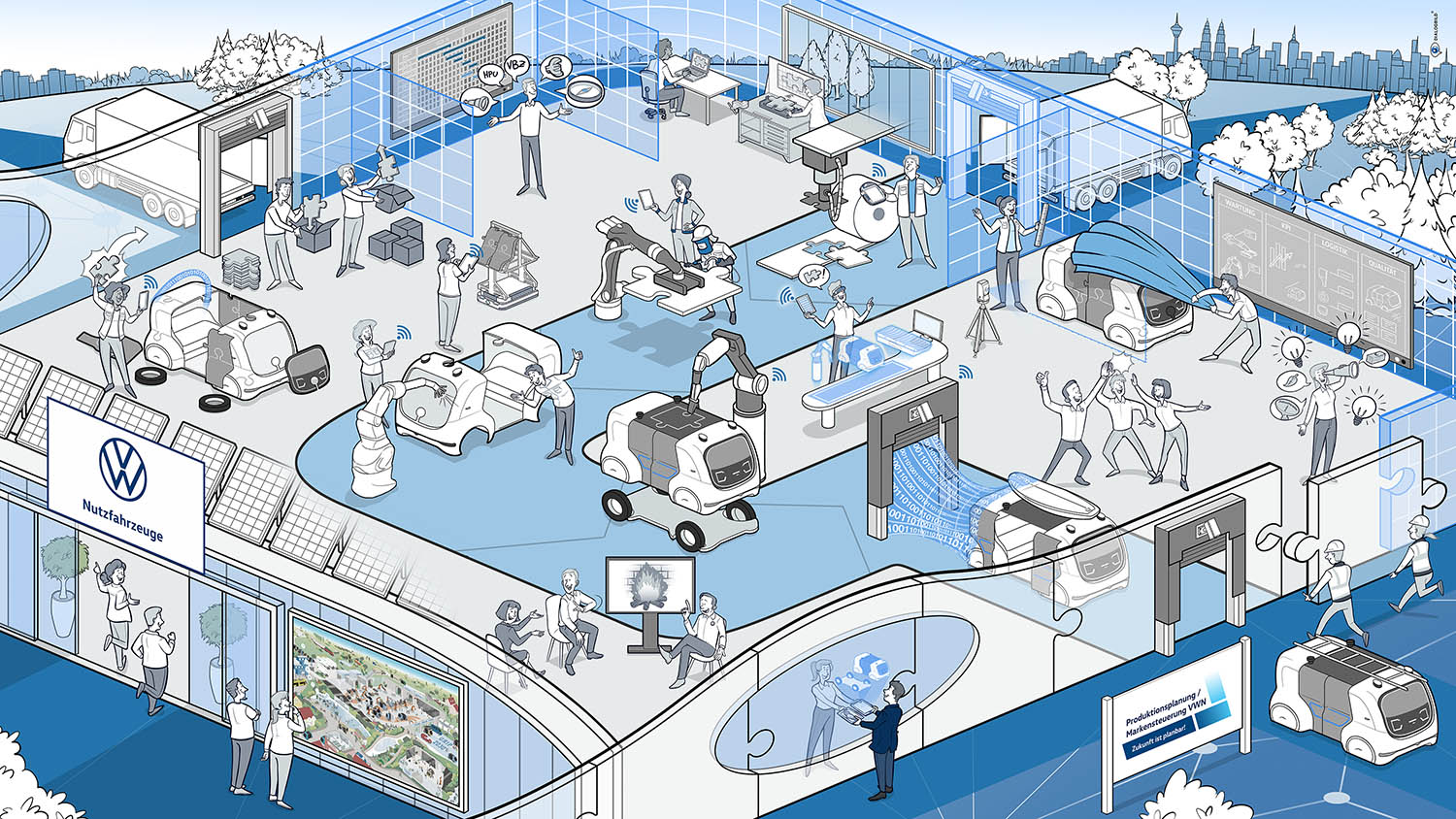
SMART PLANNING
– THE FACTORY OF THE FUTURE
With over 1,000 employees, Production Planning / Brand Management VWN makes a decisive contribution to the long-term corporate success of the Volkswagen Commercial Vehicles brand.
The department is responsible for shaping the production of tomorrow. Interdisciplinary teams develop concepts for the implementation of new vehicle projects. In addition to influencing products towards a production-oriented product design, the department also focuses on the production and on-time provision of systems and components.
As part of the strategy work, a visual world was developed in collaboration with DIALOGBILD that focuses on the interaction of the individual departments and the common goal of a SMART PLANNING factory. ...
Frequently Asked Questions: Change Process
What is a change process?
A change process describes the structured sequence of changes in an organization. It covers all steps from recognizing the need for change to its full implementation and anchoring in the corporate culture.
What phases does a typical change process go through?
A typical change process goes through the following phases:
1. Initialization: Analysis of the current state and determination of the need for change
2. Concept: Development of a change concept and definition of goals
3. Mobilization: Communicating the change and preparing those involved
Implementation: Implementation of the planned change measures
Perpetuation: Anchoring the changes in the corporate culture
What role do managers play in the change process?
Managers are key drivers of change. They must communicate the purpose of the change, provide resources, overcome resistance and create a supportive environment.
What is Lewin's 3-stage model?
Lewin's 3-stage model divides the change process into:
1. Unfreezing: Preparation for the change
2. Changing: Implementing the change
3. Freezing (Refreezing): Stabilization of the new state
How can you measure the success of a change process?
Success can be measured using various metrics, such as:
- Employee satisfaction
- Productivity increases
- Achieving project goals
- Feedback from those involved
What role does communication play in the change process?
Communication is crucial for success. It ensures that everyone involved is informed, understands the reasons for the change and knows what is expected of them.
How can you overcome resistance to change?
Strategies for overcoming resistance include:
- Involving employees in the change process
- Transparent communication of benefits and goals
- Providing training and support
- Recognize and reward willingness to adapt
What is the ADKAR model for change management?
The ADKAR model describes five main goals for successful change management:
1. Awareness (awareness of the need for change)
2. Desire (desire to support the change)
3. Knowledge (knowing how to change)
4. Ability (ability to implement new skills)
5. Reinforcement (reinforcement to maintain the change)
How can DIALOGBILD support the change process?
DIALOGBILD supports the process through:
1. Visualization of the entire process for better understanding
2. Promote communication by providing a basis for discussion
3. Emotional activation to increase acceptance
4. Orientation by depicting the path from the current to the target state
5. Motivate employees by visualizing goals and milestones
What resources are needed for a successful change process?
Important resources include:
- Sufficient budget
- Time
- Qualified workforce
- Necessary tools and technologies
- Training and support for employees
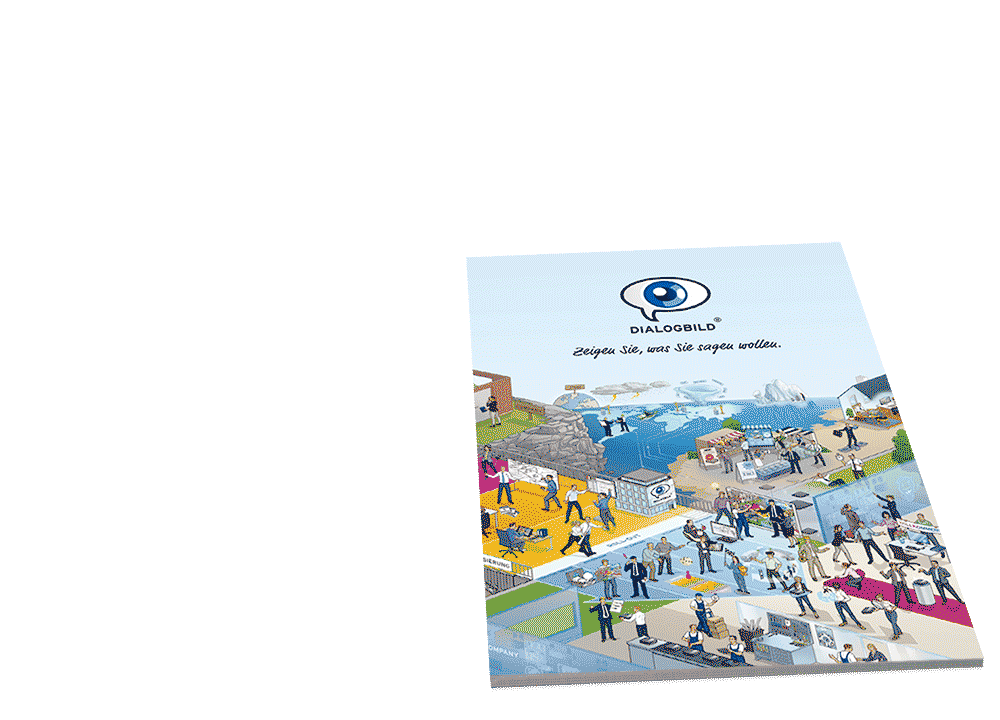 SELECT INFO PACKAGE
SELECT INFO PACKAGE